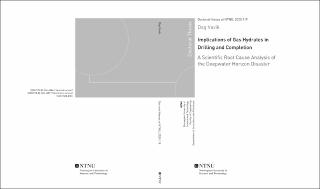| dc.description.abstract | On April 20, 2010 eleven men lost their lives in the explosion and fire on Deepwater Horizon. Previous investigations have assumed that the experienced drilling crew must have missed a cumulative gain of about 1 000 barrels before the blowout preventer (BOP) was closed. However, this fatal incident did not occur because the drilling crew failed to observe that the well was flowing. The fact that no gain or flow from the riser was observed as late as a couple of minutes before the first explosion is almost unbelievable. That is probably also why previous investigation reports have concluded that this cannot be the case. Instead of investigating why the flow meters showed no flow, they have assumed that this must be wrong.
This PhD thesis will explain the root cause of the Deepwater Horizon disaster. The gas that caused the initial explosion and fire on Deepwater Horizon, originated from a gas kick that lasted for days prior to the cement job. The hydrocarbon gas that caused the first explosion, entered the wellbore undetected during the static period between April 16 and April 19. The large gas influx that occurred over a long time period was probably not discovered due to thermal effects, gas solubility in synthetic oil-based mud (SOBM) and possibly gas hydrate formation.
The cement job was unsuccessful probably due to a crossflow event that occurred when the bottom wiper plug burst at the float collar. The high burst pressure probably fractured the formation and a large amount of fluids were lost to the formation. The loss was probably not discovered because of a simultaneous gas influx higher up in the wellbore. Simulations carried out by SINTEF shows that the gas rich sandstone with high pore pressure was underbalanced prior to bursting the bottom wiper plug.
Gas cut mud was already present in the riser when preparation for the negative pressure test took place. The booster line probably contained large amount of free gas, originated from the gas kick during the static period between April 16 and April 19. The gas was present in the well and booster line because the final step of bottoms-up circulation prior to and after the cement job was not completed. When the auxiliary lines (boost, choke and kill lines) was displaced with seawater, large amount of gas hydrates could form. Seawater and water-based spacer probably mixed with freshwater were also pumped into the well to displace the SOBM up to above the subsea BOP. Large amount of relative cold water was therefore pumped into the sealed well (production casing) that already contained large amount of gas.
Gas hydrates probably plugged the displacement string during the first negativepressure test. This confused the drilling crew to believe the first test was successful. Gas hydrates may also have contributed to the upper BOP annular did not close properly during bleed down and preparation for the negative pressure test and during the final well control actions.
Gas hydrates probably also plugged the kill line during the second negative pressure test. This confused the drilling crew to believe the second test also was successful.
Kick detection based on gain does not always work. Thermal effects, simultaneous loss of drilling fluids, hydrate formation and free gas that exit the riser at the top, may hide that a gas kick is ongoing and show net loss instead of gain. Improved methods for kick detection are strongly recommended.
Real time data and witness observations confirms that the blowout occurred extremely fast. Tons of gas hydrates had probably been circulated up the drilling riser like a “Trojan horse” after the negative pressure test was assumed to be successful. Less than 3 minutes before the first explosion a hydrate plug in the upper part of the riser came out of control. The hydrate plug travels the last part of the riser driven by liberated gas from the dissociation process of gas hydrates.
Gas hydrates partly plugging the diverter housing, probably contributed to the attempt to divert the fluids overboard through the starboard overboard line failed. Gas hydrates probably also contributed to the variable bore rams did not close properly during the final well control actions.
Gas hydrates may also have contributed to the fact that the drill pipe ended up being off center in the BOP and that the blind shear ram did not seal properly.
The fact that the subsea BOP failed to shut-in the well and that the cement job was unsuccessful allowed gas to enter the production casing from the bottom. A second “attack” probably from the same high pressure gas rich sandstone could then proceed without any restriction. The “Trojan horse” (gas hydrates) with gas from the April 16 to April 19 gas influx event has done the job. Both the subsea blowout preventer and the riser diverter system had lost their capability be prevent the blowout as intended. In this way the fatal explosion could escalate to be the largest marine oil spill in the history of the petroleum industry. | en_US |
